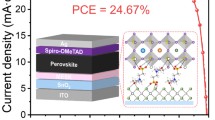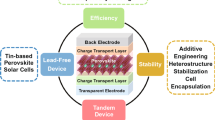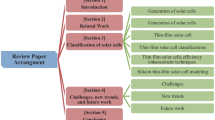Abstract
Single junction solar cells were fabricated with intrinsic hydrogenated amorphous silicon germanium (a-SiGe:H) as the active layer, that shows a 10% photovoltaic conversion efficiency. The a-SiGe:H active layer of the solar cells of type-A had constant band gap materials while that of type-B had a four step graded band gap by composition gradient (CG). The cells with composition gradient show an enhancement in fill factor and open circuit voltage (V oc) by 5% and 20 mV respectively, with respect to a cell without the graded band gap active layer. Such an enhanced device performance is attributed to reduction in recombination loss of photo-generated electron hole pairs. The effect of this photo-current loss was investigated in the electrical bias dependent external quantum efficiencies (EQE), illumination dependent current-voltage measurements and dark current-voltage characteristics. The device parameters like reverse saturation current density (J o), series resistance (R s) and diode quality factor (n) were also estimated. In comparison to the cell without the composition gradient, the EQE shows a reduced recombination loss across the whole wavelength range for the cell with the CG. Furthermore, the introduction of the CG results in a significantly increased shunt resistance from 720 to 1200 Ω.cm 2. The estimated n values of the cells under dark operating condition, decreases from 1.8 to 1.7 along with J o from 3 × 10 −7 down to 4.5 × 10 −8 A/cm 2 with CG, while the same parameters decreased from 3.73 to 3.06, 2.96 × 10 −6 to 3.05 × 10 −7 A/cm 2 respectively under AM1.5G insolation.
Similar content being viewed by others
References
Yan B, Yue G, Sivec L, Yang J, Guha S, Jiang C-S (2011) Innovative dual function nc-SiOx:H layer leading to a > 16% efficient multi-junction thin-film silicon solar cell. Appl Phys Lett 99:113512
Cho J, Pham D P, Jung J, Shin C, Park J, Kim S, Tuan Le A H, Park H, Iftiquar S M, Yi J (2016) Improvement of hydrogenated amorphous silicon germanium thin film solar cells by different p-type contact layer. Mater Sci Semicond Process 41:480–484
Cho J, Iftiquar S M, Kim M, Park J, Jung J, Kim J, Yi J (2016) Hydrogenated amorphous silicon germanium active layer for top cell of a multi junction cell structure. J Nanosci Nanotechnol 16:4870–4874
Palinginis K C, Cohen J D, Yang J C, Guha S (2000) Defect bands in a-Si–Ge:H alloys with low Ge content. J Non-Crystal Solids 266–269(Part 2):665–669
Zimmer J, Stiebig H, Wagner H (1998) a-SiGe:H based solar cells with graded absorption layer. J Appl Phys 84:611–617
Jin-Won C, Jun Woong P, Yu Jin L, Seh-Won A, Heon-Min L, Park OO (2012) Graded layer modification for high efficiency hydrogenated amorphous silicon–germanium solar cells. Japan J Appl Phys 51:10NB16
Schüttauf J-W, Niesen B, Löfgren L, Bonnet-Eymard M, Stuckelberger, M, Hänni S, Boccard M, Bugnon G, Despeisse M, Haug F-J, Meillaud F, Ballif C (2015) Amorphous silicon–germanium for triple and quadruple junction thin-film silicon based solar cells. Solar Energy Mater Solar Cells 133:163–169
Lundszien D, Finger F, Wagner H (2002) A-Si:H buffer in a-SiGe:H solar cells. Solar Energy Mater Solar Cells 74:365–372
Lundszien D, Yong F, Finger F (2002) The influence of the optical band gap of buffer layers at the p/i- and i/n-side on the performance of amorphous silicon germanium solar cells. In: Photovoltaic specialists conference, 2002. Conference record of the twenty-ninth. IEEE, pp 1218–1221
Krajangsang T, Inthisang S, Dousse A, Moollakorn A, Hongsingthong, A, Kittisontirak S, Chinnavornrungsee P, Limmanee, A, Sritharathikhun J, Sriprapha K (2016) Band gap profiles of intrinsic amorphous silicon germanium films and their application to amorphous silicon germanium heterojunction solar cells. Opt Mater 51:245–249
Liu B, Bai L, Zhang X, Wei C, Huang Q, Sun J, Ren H, Hou G, Zhao Y (2015) Fill factor improvement in PIN type hydrogenated amorphous silicon germanium thin film solar cells: omnipotent N type μc-SiOx:H layer. Solar Energy Mater Solar Cells 140:450–456
Biron R, Pahud C, Haug F-J, Ballif C (2012) Origin of the V oc enhancement with a p-doped nc-SiOx:H window layer in n-i-p solar cells. J Non-Crystal Solids 358:1958–1961
Park H, Iftiquar SM, Kim HW, Lee J, Le AHT, Yi J (2013) Diffused transmission and texture-induced defect with transparent conducting oxide front electrode of amorphous silicon solar cell. Semicond Sci Technol 28:115012
Stangl R, Haschke J, Leendertz C (2009) Numerical simulation of solar cells and solar cell characterization methods: the open-source on demand program Afors-het, Version 2.4 Rugescu R D (ed), Solarenergy, Intech, Croatia
Hegedus S S, Shafarman W N (2004) Thin-film solar cells: device measurements and analysis. Progress Photovolt Res Appl 12:155–176
Hegedus S S (1997) Current–voltage analysis of a-Si and a-SiGe solar cells including voltage-dependent photocurrent collection. Progress Photovolt Res Appl 5:151–168
Deng J, Wronski CR (2005) Carrier recombination and differential diode quality factors in the dark forward bias current-voltage characteristics of a-Si:H solar cells. J Appl Phys 98:024509
Deng J, Pearce J M, Koval R J, Vlahos V, Collins R W, Wronski C R (2003) Absence of carrier recombination associated with the defect pool model in intrinsic amorphous silicon layers. Evidence from current–voltage characteristics on p–i–n and n–i–p solar cells. Appl Phys Lett 82:3023–3025
Fang J, Chen Z, Hou G, Wang F, Chen X, Wei C, Wang G, Sun J, Zhang D, Zhao Y, Zhang X (2015) High-quality hydrogenated intrinsic amorphous silicon oxide layers treated by H 2 plasma used as the p/i buffer layers in hydrogenated amorphous silicon solar cells. Solar Energy Mater Solar Cells 136:172–176
Guha S, Yang J, Pawlikiewicz A, Glatfelter T, Ross R, Ovshinsky, S R (1989) Band-gap profiling for improving the efficiency of amorphous silicon alloy solar cells. Appl Phys Lett 54:2330– 2332
Jimenez Zambrano R, Rubinelli F A, Rath J K, Schropp R E I (2002) Improvement in the spectral responseat long wavelength of a-SiGe:H solar cells by exponential band gap design of the i-layer. J Non-Crystal Solids 299–302(Part 2):1131–1135
Moon SY, You D J, Lee S E, Lee H (2013) In-situ monitoring and control of hydrogenated amorphous silicon–germanium band-gap profiling during plasma deposition process. Curr Appl Phys 13:1502–1505
Zambrano RJ, Rubinelli F A, Arnoldbik W M, Rath J K, Schropp R E I (2004) Computer-aided band gap engineering and experimental verification of amorphous silicon–germanium solar cells. Solar Energy Mater Solar Cells 81:73–86
Tang Z, Wang W, Wang D, Liu D, Liu Q, Yin M, He D (2010) The effect of Ar flow rate in the growth of SiGe:H thin films by PECVD. Appl Surf Sci 256:7032–7036
Pieters BE, Zeman M, van Swaaij R A C M M, Metselaar W J (2004) Optimization of a-SiGe:H solar cells with graded intrinsic layers using integrated optical and electrical modeling. Thin Solid Films 451–452:294–297
Abu-Ras D, Kirchartz T, Rau U (2011) Advanced characterization techniques for thin film solar cells. Wiley-VCH, Germany
Banerjee A, Xu X, Yang J, Guha S (1995) Carrier collection losses in amorphous silicon and amorphous silicon–germanium alloy solar cells. Appl Phys Lett 67:2975–2977
Chung Y-B, Lee D-K, Lim J-S, Hwang N-M (2011) Reduction of amorphous incubation layer by HCl addition during deposition of microcrystalline silicon by hot-wire chemical vapor deposition. Solar Energy Mater Solar Cells 95:211–214
Iftiquar SM, Yi J (2016) Low reverse saturation current density of amorphous silicon solar cell due to reduced thickness of active layer. J Electr Eng Technol 11:939–942
Author information
Authors and Affiliations
Corresponding authors
Rights and permissions
About this article
Cite this article
Pham, D.P., Kim, S., Park, J. et al. Reduction in Photocurrent Loss and Improvement in Performance of Single Junction Solar Cell Due to Multistep Grading of Hydrogenated Amorphous Silicon Germanium Active Layer. Silicon 10, 759–767 (2018). https://doi.org/10.1007/s12633-016-9527-4
Received:
Accepted:
Published:
Issue Date:
DOI: https://doi.org/10.1007/s12633-016-9527-4




